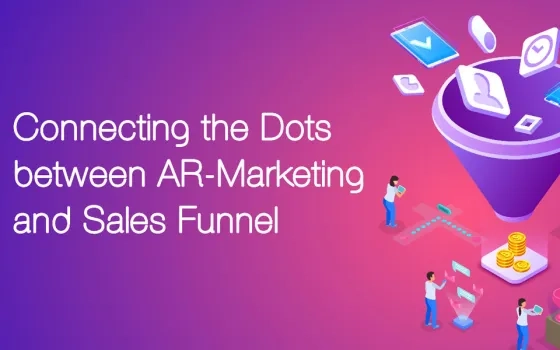The very definition of marketing is dynamic and ever-changing. Businesses that understand this essence and adopt various means to integrate new-age marketing approaches see a definite change in the outcome from their sales funnel.
I remember my dad flipping through the newspaper early in the morning. I was always intrigued with those colorful adverts in the newspaper and sat down on numerous occasions with him to talk. This is just one single strand among the marketing techniques if I were to pick. The world has already seen the marketing approach move with time from traditional print media to television media to digital marketing. Now there’s a new medium, AR-enabled marketing that’s making the news. So does this new foray into AR-enabled marketing increase the conversion of prospects into customers? Let’s find out.
Vision is the foundation of Augmented Reality Marketing
If you were to look at Augmented Reality marketing from a customer perspective model, it can be seen as the long list of omnichannel trigger points aimed to provide enhanced customer experience and immersive interaction. Each of these triggers are integrated with measurable action points like clicks, QR scans, trackers, and more.
It’s similar to other existing marketing mediums in the sense that they all come with measurable action points. But it’s the execution and the vision that separates the AR marketing and gives it an upper hand. Leveraging modern-day tech to create a completely new immersive customer experience is critical and the very foundation of new-age marketing.
The Coherence between Marketing and Sales
Most businesses don’t perceive the notion of marketing as a broader term. For them, the term marketing remains about reaching the end-user and getting the message across, ultimately resulting in sales. Marketing on a general note is equated to the four P’s; product, pricing, place, and promotion. The concept first phrased back in the 1950s has been a cornerstone for marketing, and brands have been vying to enhance their relationships with potential customers through various interactive means.

However, as the customer buying habits have evolved, so has the brand’s approach to marketing. Modern-day marketing practices have been in line with the way customers are approaching the product and their preferences. Marketing plays a vital role in the end sales by playing a critical role in nurturing their journey through to the sales funnel. This in itself is a major message that should not be ignored. Marketing and sales are correlated and should be in coherence with each other. Brands that streamline the marketing approach with ties in the sales methodology see healthier growth and higher conversion in leads.
Delving into the Sales Funnel
The stages of the sales funnel, namely; Awareness, Interest, Decision, and Action remain the holy grail for any business seeking to penetrate the market and gain customers. However, as the marketing approach has improvised over time, the same has been with the sales funnel.

Brands these days are more than what they do. They need to provide a seamless alignment and integration between belief and brand practice. Nowadays, customers are inclined towards knowledge and prefer being part of something good. This requires brands to integrate their sales strategy with the onus of enhancing the digital customer experience. It also paves way for the brands to incorporate new-age technologies like digital, voice, gesture, or even augmented or mixed reality led experiences that are distinct and immersive.
- Awareness: A critical part of generating revenue is to lure the customer via awareness into the sales funnel. But having said that, you cannot merely design a sales funnel and expect the customers to come flooding in. You need to have key touchpoints that can entice the customers. The traditional marketing approach has been all about providing a variety of interactions like newsletter signups, downloads, rewards, and more. Today, the customers are more aware than ever and the traditional approach will put the business in jeopardy. The underlying question for brands is how they can tap this new-age informed customers and create long-term relationships.
- Interest: Generating interest and captivating the audience creates a seismic shift from prospects transforming from general over-viewers to interested ones. For this, brands must acclimatize their campaign into an interactive one. Brands should create an authentic and promising context that customers can relate to and follow in turn. This builds the interest of the customers and increases the chances of them continuing into the sales funnel.
- Decision: Getting the prospects to make a decision is easier said than done. With customer experience transforming to a creative experience, users are more aware than ever. Prospects turn into customers only when they can relate and find their desired solutions. Turning the leads into qualification requires handling the possible outcome and minimizing the chances of loss. The onus is to win the deal via getting the customer onboard. Robert Cialdini in his book outlines 6 principles that can get the customers to act and take decisions in this stage.
- Action: The final stage is oriented towards the action that you desire from your customers. Generally, it’s the purchase. This part of the sales funnel helps provide the net conversion ratio and gives brands the actual value that they are generating out of the multiple leads and sources. Smart marketers often base their campaigns and plan accordingly to the scale and outcome of the business. This step may seem like the final frontier of sales yet it provides the complete overview and game-changing metrics for brands to adjust.
Connecting the Dots Between AR-Marketing and Sales Funnel
Micheal H. Goldhaber published a beautiful piece in 1997 about how attention will likely become the new currency of the economy. Brands these days need to cater to generating awareness and attention which in turn will lead to understanding the persona of the buyer properly. When a brand understands the buyer personas and prioritizes delivering the experience coupled with the optimum service, this is where brands can get the most out of their sales funnel. The below-attached image showcases the present-day challenge for brands when it comes to marketing to B2B buyers:

Underlying the issues and developing intricate solutions to mitigate the same is extremely important for marketers to create improved conversions and higher engagements. Where previous marketing techniques had sufficed to provide brands with enough leverage, with time they are dwindling. Over 58% of the CMO’s have identified the use of modern technology as a key factor in building a differentiated customer experience. Innovative and immersive experiences are at the heart of modern-day customer behavior and improving your brand practices in accordance with the same is much warranted.
Augmented Reality marketing solutions are a highly customizable marketing medium rather than being a standalone tool. It can be easily integrated with the existing marketing campaigns of the brand to increase conversions and scale the reach. Augmented Reality based marketing is more about increasing the immersive experience, improving the digital quotient of the user, and providing the trendsetting experience for a personalized brand approach.

When comparing the metrics for Return on Investment for B2B Marketers, the traditional approach gave 2x returns only in 16.3% cases. The same when aided by Augmented Reality-based marketing solutions provided 2x returns in over 62% cases.
Furthermore, Augmented Reality adoption is rising with time with over 27% adoption among the CMO’s in a bid to create future-oriented customer engagement for the prospects.
Rethink your brand perception with Augmented Reality-enabled Marketing Solutions
Augmented Reality-enabled marketing solutions aim to provide transparency and create a deeper connection with the prospects. It’s in line with the needs of the modern-day user who focuses not just on being the end-user but being part of the entire journey. Users these days are streamlined to follow brands that can provide a calling and brand voice. This is where AR can help provide that final boost in generating awareness and accelerate understanding.
With the attention span of the user declining with time, brands need to capitalize on the very first impression and immersive marketing solutions are best placed to handle it. This can also pave the way for brands to tap into the wider spectrum of the user base and generate marketable opportunities among Gen Z and the new age population who are well versed in digital technology transformation.


















